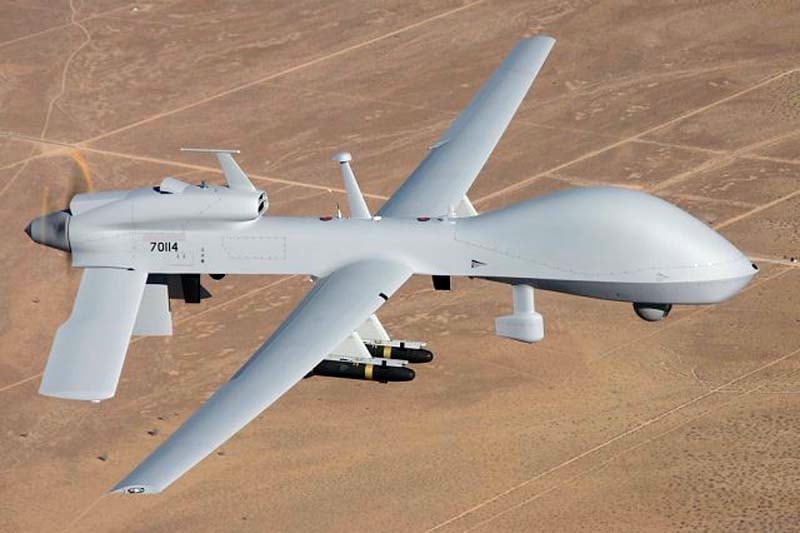The Army is looking at mirroring the way the Air Force operates its large unmanned aerial systems.
The Air Force’s MQ-1 Predators and MQ-9 Reapers flown halfway around the world are controlled from a remote location within the U.S. via satellite link. But the Army’s MQ-1C Gray Eagles — which are division assets used at the tactical and operational levels, and are manufactured by the same company as the Predator and Reaper — are operated locally in theater.
“From an Army perspective, we typically take our assets to theater and we fight them in that battle space with those operators that are there ... as opposed to fighting them from back here at [the continental United States],” Army Col. Paul Cravey told C4ISRNET in an interview.
“I do see the Army looking at expanding the method in which the Gray Eagle is employed. The Army [Intelligence and Security Command] community is looking at whether this [platform] can be employed much like the Reaper is employed from home station, from CONUS and operated from CONUS and executed via satellite control in an OCONUS scenario, much like the Predators are flown now,” said Cravey, the Army‘s Training and Doctrine Command capability manager for reconnaissance and attack at the Aviation Center of Excellence.
“There’s a lot of research and some potential experiments are going to go on to use the Gray Eagle in that mode.”
Cravey noted that the Army has successfully conducted these types of remote operations at the National Training Center in California with operators executing flight operations from Fort Hood, Texas, via satellite links.
“We know we can do that, but we are probably going to do more experiments to expand that to determine if there’s benefit in operating that way from the Army,” he said, adding that the service is looking to determine the viability of fighting from CONUS to OCONUS.
General Atomics Aeronautical Systems, which manufactures the Predator, Reaper and Gray Eagle, is looking to apply lessons learned from the Reaper and Predator to its Gray Eagle. The Air Force has employed and evolved large unmanned platforms for the last 20 years, and officials are realizing the “untapped potential” of the aircraft.
[Reaper drones have ‘untapped potential,’ says top Air Force official]
“We’re in a unique position at General Atomics because we can take those lessons learned and experience that the Air Force is gaining in the missions that they’re using their [remotely piloted aircraft] for and bringing those and we work with [Army Program Manager] UAS,” Chris MacFarland, General Atomics Aeronautical Systems‘ director of Army programs, told C4ISRNET in an interview.
The Department of Defense has indicated it wants to get to 90 global unmanned combat air patrols by 2019. Under this plan, the Air Force would operate 60 as it currently does, contractors would operate 10, the Army would operate up to 16 and U.S. Special Operations Command would operate up to four.
[Air Force RPA ‘get well’ plan on track]
Open architecture
Cravey also noted that the Army has several requests from a variety of stakeholders within the service to integrate different capabilities and payloads on the Gray Eagle.
Over time, some of these capabilities will make the cut in prioritization and resourcing while others won’t he said.
“We’re fighting them now with an [electro-optical/infrared] camera, and it’s kinetic depending on the theater you’re in. It’s kinetic in Iraq and less kinetic and more ISR-centric in Afghanistan,” Cravey said.
Given the variety of needs and desires of commanders as it applies to payloads aboard Gray Eagles, the full adoption of open architecture — a direction the entire DoD is moving toward — will be critical.
“The open architecture is key, and we don’t have full open architecture in our systems across the Army right now, and that’s really become a … drive for who gets selected from industry in the acquisition process, as it’s a requirement to have open architecture so we don’t wind up in vendor lock … or exponential integration costs because we can’t do it ourself for whatever payload that we want to put on these platforms,” Cravey said.
He added that in the future, a commander will have to select what payloads they want aboard an asset. And given the aircraft can’t carry everything, a commander will have to tailor the payloads for the mission, he continued.
There won’t be different versions of the Gray Eagle, Cravey said, but rather different payloads that can be tailored to a specific mission.
“The Korea fight is going to be different than the fight in Southeast Asia, which is going to be different than the fight in southeastern Europe. What are the gaps you need to fill? Is that something we need to look at with the PM for evolving the aircraft to support? Sometimes it’s as simple as a hardpoint modification and sometimes it may be an architecture design,” MacFarland said of ongoing discussions with the Army to evolve its platform to meet mission needs.
MacFarland added that there’s a program within General Atomics Aeronautical Systems where the technology that supports a universal payload interface, or other projects on which the Air Force may be working, can be migrated from the Reaper community to that of the Gray Eagle.
Mark Pomerleau is a reporter for C4ISRNET, covering information warfare and cyberspace.







